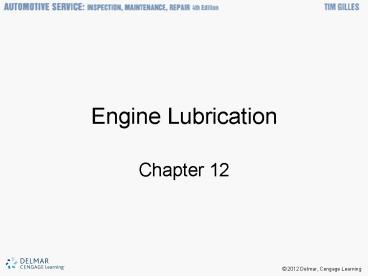Engine Lubrication - PowerPoint PPT Presentation
1 / 25
Title:
Engine Lubrication
Description:
Engine Lubrication Chapter 12 Objectives Describe engine lubrication under different service conditions Select the correct engine oil to use Describe the operation of ... – PowerPoint PPT presentation
Number of Views:68
Avg rating:3.0/5.0
Title: Engine Lubrication
1
Engine Lubrication
- Chapter 12
2
Objectives
- Describe engine lubrication under different
service conditions - Select the correct engine oil to use
- Describe the operation of different types of oil
filters
3
Introduction
- All moving parts are separated by a thin oil
layer - Oil pump supplies oil to the engine
- Little wear should occur if oil is maintained
properly
4
(No Transcript)
5
Engine Oil
- More than basic crude
- Contains a complicated additive package
- First additives were developed in the 1930s
- Does more than lubricate
- Cools, cleans, and prevents rust
- Fills hydraulic valve lifters or cam followers
- Helps seal piston rings against cylinders
6
Engine Oil (cont'd.)
- Oil level
- Correct level is designed to keep the oil pickup
screen below the level of the oil - When checking oil level
- Vehicle should be on a level surface
- Engine should be warm but off for five minutes
- Push dipstick all the way down
- If level is unclear look at back of dipstick or
re-dip - If level is low check if the vehicle is due for
service
7
(No Transcript)
8
(No Transcript)
9
Engine Oil (cont'd.)
- Oil viscosity
- Oil thickness or body
- Multiple viscosity oils
- Most new engine oils are multiple viscosity
- Viscosity index
- Ability to resist change in viscosity under
increased heat
10
Engine Oil (cont'd.)
- Oil pressure
- Develops when there is a resistance to flow
- As engine wears, clearance between crankshaft and
bearings increases - Oil pump cannot fill extra clearance
- Oil pressure is low when engine idles
- SAE 20W-50 provides higher oil pressure in older,
idling engines - Flows more slowly to bearings of new engine when
first started on a cold morning
11
Engine Oil Licensing and Certification
- SAE decides when new oil specifications are
needed - American Society for Testing and Materials
- Sets performance specifications
- American Petroleum Institute
- Administers the licensing and certification
- Starburst symbol
- API licenses engine oil marketers to display its
starburst certification mark
12
(No Transcript)
13
Engine Oil Licensing and Certification (cont'd.)
- Oil service ratings
- Set by API
- SA through SN
- SA mineral oil with no additives and is not
recommended for automotive use - S used for engines with a spark
- Diesel engine oils rated CA through CJ
14
Engine Oil Licensing and Certification (cont'd.)
- European ACEA oils
- ACEA standards developed by European auto
manufacturers - Manufacturer-specific oil standards
- Becoming more common
- Energy-efficient oils
- Oil is energy conserving if it passes certain
tests - Energy conservation ratings began in 1994
- HTHS viscosity rating
- Measures viscosity under difficult conditions
15
Oil Additives
- Additives make up as much as one-third of the
volume of the oil - Additives found in engine oil
- Pour-point depressants
- Corrosion and rust inhibitors
- Antifoam additives
- Friction modifiers
- Oxidation inhibitors
- Antiwear additives
16
Oil Additives (cont'd.)
- Boundary lubrication
- Film becomes too thin or breaks down under load
- Detergents and dispersants
- Keep small particles suspended
- As oil decomposes at high temperatures it reacts
with oxygen to form a gummy mixture - Detergents make deposits oil soluble
- Sludge
- Mixture of moisture, oil, and contaminants
- Clogs oil screen and oil lines if it accumulates
17
(No Transcript)
18
Oil Additives (cont'd.)
- Nondetergent oil
- Oil without additives is called
- Oil oxidizes at temperatures higher than 250F
- Becomes thicker and forms varnish deposits
- Oxidation rate doubles every 20F above 140F
- Antioxidants combat the effects of heat on the
oil - Detergents make varnish oil soluble
19
Synthetic Oils
- Molecules are nearly the same size
- Reduces friction
- Contain no wax or impurities
- Suited to lower temperatures
- Can also withstand higher temperatures
- Advantages
- Lower oil consumption
- Can be changed less frequently
- Disadvantage
- Price
20
Changing Engine Oil
- Benefits of changing the oil
- Oil additives are depleted over time
- Cleans smaller contaminants from the oil
- Unburned contaminants are removed with the oil
- Sludge is removed
- Oil change intervals
- Vehicles driven primarily on the highway can
change oil every 7,500 miles - Newer engines with VTT require regular oil
changes with high-quality, low-viscosity oil
21
Changing Engine oil (cont'd.)
- Changing brands of oil
- Avoid mixing brands between oil changes
- Best done when the oil is being changed
- Use any brand of high-grade oil when there is no
choice of brand available - Changing oil
- Best to change oil when it is still hot
- Mileage service record usually a sticker
- Oil monitor system reset
- Included in many late-model vehicles
22
(No Transcript)
23
Oil Filter
- Prevents harmful abrasive particles in the oil
from damaging internal parts - Today's cars use the full-flow oil filter
- Must have a by-pass valve
- Horizontal mounted filters
- Have an anti-drainback valve
- By-pass oil filters
- Supplemental add-on filters used on heavy trucks
- Variations in filters
- Identified by a number printed on the metal shell
24
(No Transcript)
25
Changing the Oil Filter
- Considerations
- Sheet metal shell on filter is very thin
- Rubber O-ring seals filter against engine block
- Make sure there is not an old seal stuck to the
engine block - Lubricate the O-ring with oil prior to
installation - Most filters have instructions printed on the
outside - Overtightening will make future removal difficult































